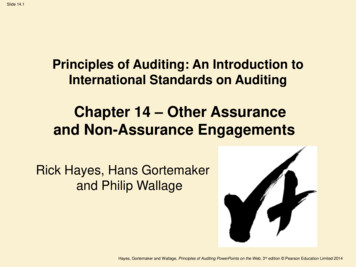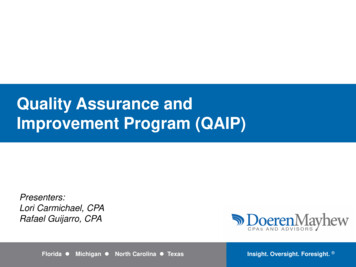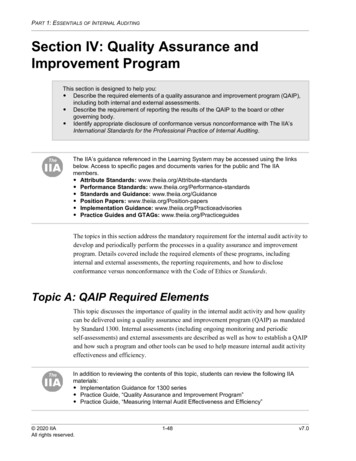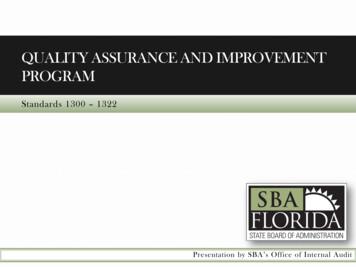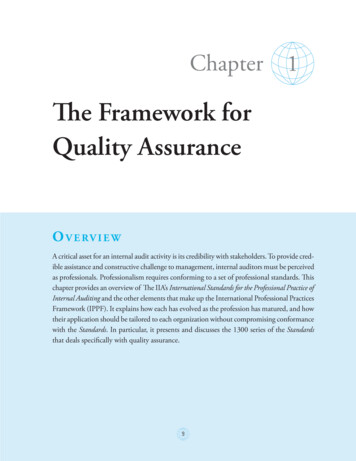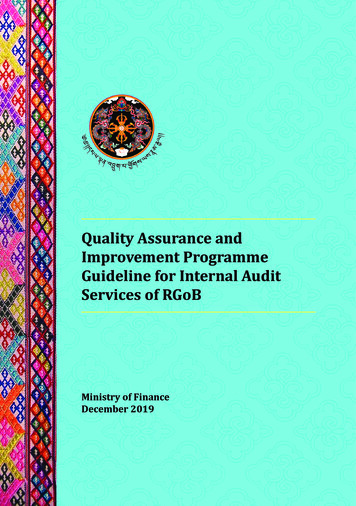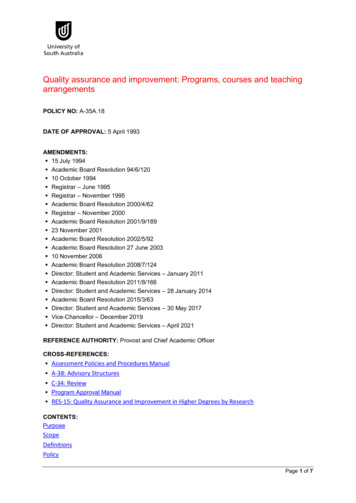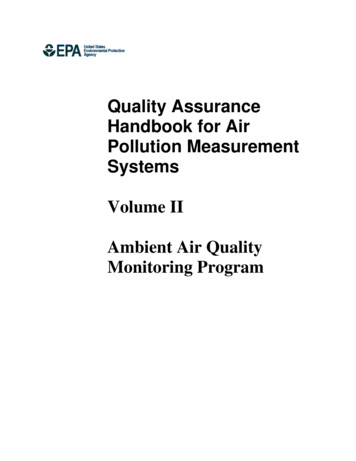
Transcription
Quality AssuranceHandbook for AirPollution MeasurementSystemsVolume IIAmbient Air QualityMonitoring Program
Page Intentionally Left Blank
EPA-454/B-17-001January 2017Quality Assurance Handbook for Air Pollution MeasurementSystemsVolume IIAmbient Air Quality Monitoring ProgramU.S. Environmental Protection AgencyOffice of Air Quality Planning and StandardsAir Quality Assessment DivisionRTP, NC 27711
QA Handbook Volume IIJanuary mentsAcronyms and Abbreviations0. Introduction0.1 Intent of the Handbook0.2 Use of Terms Shall, Must, Should, May0.3 Use of Footnotes0.4 Handbook Review and DistributionPROJECT MANAGEMENT1. Program Background1.1 Ambient Air Quality Monitoring Network1.2 The EPA Quality System Requirements1.3 The Ambient Air Monitoring Program Quality System2. Program Organization2.1 Organization Responsibilities2.2 Lines of Communication3. Data Quality Objectives3.1 The DQO Process3.2 Ambient Air Quality DQOs3.2 Measurement Quality Objectives4. Personnel Qualification and Training4.1 Personnel Qualifications4.2 Training5. Documentation and Records5.1 Management and Organization5.2 Site Information5.3 Environmental Data Operations5.4 Raw Data5.5 Data Reporting5.6 Data Management5.7 Quality AssuranceMEASUREMENT ACQUISITION6. Monitoring Network Design6.1 Monitoring Objectives and Spatial Scales6.2 Monitoring Site Location6.3 Minimum Network Requirements6.4 Operating Schedules6.5 Network Plan Reporting7. The Sampling System7.1 Monitor Placement7.2 Environmental Control7.3 Sampling Probes and Manifolds7.4 Reference/Equivalent and Approved Regional Methods8. Sample Handling and Custody8.1 Sample Handling8.2 Chain of Custody9. Analytical Methods9.1 Good Laboratory Practices9.2 Laboratory 11/1512/1515/151/172/175/1713/172/75/701/173/33/3
QA Handbook Volume IIJanuary 2017SectionPage10. Quality Control10.1 The Quality Control Process10.2 QC Activity Areas10.3 Internal vs. External Quality Control10.4 CFR Related Quality Control Samples10.5 Use of Computers for Quality Control11. Instrument/Equipment Testing, Inspection, and Maintenance11.1 Instrumentation11.2 Preventative Maintenance12. Calibration12.1 Calibration Standards and Reagents12.2 Calibration Procedures12.3 Multi-point Verifications12.4 Frequency of Calibration and Analyzer Adjustment12.5 Validation of Ambient Data Based on Calibration Info.13 Inspection/Acceptance for Supplies and Consumables13.1 Supplies Management13.2 Standards and Reagents13.3 Volumetric Glassware13.4 Sample Containers13.5 Particulate Sampling Filters13.6 Field Supplies14. Data Acquisition and Management14.1 Data Acquisition14.2 Data Transfer-Public Reporting14.3 Data Transfer-Reporting to External Data Bases14.4 Data ManagementASSESSMENT/OVERSIGHT15. Assessment and Corrective Action15.1 Network Reviews15.2 Performance Evaluations15.3 Technical Systems Audits15.4 Data Quality Assessments16. Reports to Management16.1 Guidelines for Preparation of Reports to ManagementDATA VALIDATION AND USABILITY17. Data Review, Verification, Validation17.1 Data Review Methods17.2 Data Verification Methods17.3 Data Validation Methods18. Reconciliation with Data Quality Objectives18.1 Five Steps of the DQA ProcessAPPENDICESA. National Air Quality Monitoring Program Fact SheetsB: Ambient Air Monitoring QA Information and Web AddressesC: Using the Graded Approach for the Development of QMPs and QAPPsD: Measurement Quality Objectives and Validation TemplatesE: Characteristics of Spatial Scales Related to Each PollutantF: Sample Manifold Design for Precursor Gas MonitoringG: Example Procedure for Calibrating Data Acquisition SystemH: Audit InformationI: Example of Reports to ManagementJ: Guidance for Use of Electronic LogbooksK: Guidance for Verification of Zero Air GeneratorsL: Rounding Policy for Evaluating NAAQS QA/QC Acceptance 33482518105
QA Handbook Volume IIJanuary 8.3TitleAmbient air quality monitoring processHierarchy of quality system developmentAmbient Air Quality Monitoring QA ProgramExample Quality BulletinProgram organization and lines of communicationRelationship of monitored pollutants to site, monitoring organizations andprimary quality assurance organizationsEffect of positive bias on the annual average estimate resulting in a falserejection errorEffect of negative bias on the annual average estimate resulting in a falseacceptance errorWind rose patternSampling schedule based on ratio to the 24-hour PM10 NAAQSExample design for shelterIndividual sample line design for air monitoringViews of sampling inletsPosition of calibration line in sampling manifoldAcceptable areas for PM10 and PM2.5 micro, middle, neighborhood, andurban samplers except for microscale canyon sitesOptical mounting platformExamples of contaminated tubing and manifolds needing more frequentmaintenanceExample sample labelExample field COC formExample laboratory COC formQC samples for PM2.5 placed at various stages of measurement processHistorical example of calibration, span and 1-point QCAn example approach for selecting QC check rangesOzone calibrationControl chart exampleElectronic Chart Display of an SO2 Calibration ProcedureDASC Calibration ToolCalibration/Verification Process Flow ChartDAS data flowFlow of data from gas analyzers to final reportingDefinition of independent assessmentPre-Audit activitiesOn-Site audit activitiesAudit finding formPost-audit activitiesAudit response formDQA in the context of data life cycleExample DASC ToolExample Box and Whisker /1415/1518/218/1018/11
QA Handbook Volume IIJanuary 16-318-118-218-3TitleMonitoring Functions the Need Some Level of Staffing or ExpertiseSuggested Sequence of Core QA Related Ambient Air Training Courses Types of Information the Should be Retained Through Document ControlRelationship Among Monitoring Objectives and Scale of RepresentativenessSummary of Spatial Scales for SLAMS, NCore, PAMS, and Open Path SitesRelationships of Topography, Air Flow, and Monitoring Site SelectionCompleteness Goals for Ambient Monitoring DataEnvironment Control ParametersSummary of Probe and Monitoring Path Siting CriteriaMinimum Separation Distance between Road and Sampling Probes Performance Specifications for Automated MethodsAcceptable Analytical MethodsQC Samples Used in Various Ambient Air Monitoring ProgramsPM2.5 Field and Lab QC ChecksRoutine Operation ChecksInstrumentation and Devices Requiring Calibration and CertificationsAQS Data Reporting RequirementsAQS Agency RolesData Certification and Concurrence Flag ValuesNCore Information Technology Performance NeedsNational Performance Evaluation Activities Performed by EPASuggested Elements of an Audit PlanTypes of QA Reports to ManagementSources of Information for Preparing Reports to ManagementPresentation Methods for Use in Reports to ManagementSummary of Violations of DQO AssumptionsWeights for Estimating Three-Year Bias and PrecisionSummary of Bias and 15/515/1216/216/216/318/618/618/9
QA Handbook Volume IIJanuary 2017AcknowledgmentsThis QA Hand Book is the product of the combined efforts of the EPA Office of Air Quality Planning andStandards, the EPA Regional Offices, and the State, Tribal and Local monitoring organizations. Thedevelopment and review of the material found in this document was accomplished through the activitiesof the QA Strategy Workgroup. The following individuals are acknowledged for their contributions.State, Tribal and Local OrganizationsAmanda Hughes, Andy Clifton, Andy Johnson, Anna Kelley, Arun Roychowdhury, Barb Regynski, BenDavis, Bethany Head, Bradley Webber, Brian Lee, Bryan Paris, Ceresa Stewart, Charles Pearson, ChrisWood, Cindy Wike, Clyde Sharp, David Johnson, David Mannis, Dennis Fenlon, Don Gourley, DonovanRafferty, Dustin Kuebler, Edwin Gluth, Erik Saganic, Gary Ensminger, Glenn Gehring, HarleenKhangura, Hien Tran, Hugh Tom, James Jordan, Jason Low, Jeff Francis, Jeff Wasson, Jeremy Hardin,Jill Schulte, Jim Conner, Joel Maddy, Joette Steger, John Haus, Joseph Ugorowski, Kate Hoag, KiritDalal, Ken Cowen, Kent Curtis, Kevin Watts, Leonard Marine, Larry Taylor, Leroy Williams, MerrinWright, Mary Kay M. Clark, Melinda Ronca-Battista, Melvin Schuchardt, Mickey Palmer, Mike Draper,Mike Hamdan, Nathan Stroup, Nydia Burdick, Patti DeLaCruz, Paul Lang, Paul Sanborn, RanjitBhullar, Rayna Broadway, Richard Heffern, Ritchie Scott, Robert Franicevich, Robert Olson, RyanCallison, Sean Lundblad, Sean Nolan, Scott Reynolds, Stephen Hall, Steve Miller, Susan Kilmer, SusanSelby, Tammy Eagan, Tim Carroll, Tom Koehler, Thomas McGrath, Tyler Muxworthy, SandraWardwell, Will Wetherell, Yousaf HameedEPA RegionsRegion1 Chris St.Germain, Mary Jane Cuzzupe, Peter Kahn, Robert Judge2 Avraham Teitz, Mark Winter, Mustafa Mustafa,3 Kia Hence, Loretta Hyden4 Danny France, Doug Jager, Richard Guillot, Stephanie McCarthy5 Anthony Ross, Bilal Qazzaz, Basim Dihu, Scott Hamilton, Gordon Jones6 Trisha Curran, Kara Allen, John Lay7 James Regehr, Leland Grooms, Michael Davis, Thien Bui8 Michael Copeland, Richard Payton, Joe Delwiche, Ethan Brown9 Elfego Felix, Gwen Yoshimura, Larry Biland, Mathew Plate, Michael Flagg, Meredith Kurpius,Roseanne Sakamoto,10 Chris HallOffice of Radiation and Indoor AirMontgomery, AL - Eric Boswell, Jewell Smiley, Steve TaylorLas Vegas, NV - Emilio Braganza, Jeff LantzOffice of Air Quality Planning and StandardsKevin Cavender, Robert Coats, Dennis Crumpler, Joseph Elkins, Tim Hanley, Elizabeth Landis, DennisMikel, Jonathan Miller, Greg Noah, Joann Rice, Solomon Ricks, Mark Shanis, David Shelow, JeniaTufts, Lewis Weinstockviii
QA Handbook Volume IIJanuary 2017Acronyms and GMISHAPHCHPLCHVACICPIMPROVEITLDLLIMS MDLMFCAmbient Air Monitoring GroupAir Pollution Training Instituteaudit of data qualityAnnual monitoring network planAmbient Monitoring Technical Information CenterAmerican National Standards InstituteAir Quality Assessment DivisionAir Quality IndexAir Quality Systemapproved regional methodAmerican Society for Testing and MaterialsAmerican Society for QualityAir and Waste Management AssociationClean Air ActCode of Federal Regulationsconfidence limitcore-based statistical areacombined metropolitan statistical areachain of custodycentral processing unitcombined statistical areaPM2.5 Chemical Speciation Networkcertified reference materialcoefficient of variationdata acquisition systemData Assessment Statistical Calculatordirect currentdata quality assessmentdigital aerosol photometerdata quality indicatorsdata quality objectivesenvironmental data operationenergy dispersive x-ray flouresenceEnvironmental Protection Agencyfederal equivalent methodflow ratefederal reference methodfourier transform infrared (spectroscopy)gas chromatography mass spectrometrygeographical information systemsgood laboratory practicegas manufactures internal standardshazardous air pollutantshydrocarbonhigh performance liquid chromatographyheating, ventilating and air conditioninginductively coupled plasmaInteragency Monitoring of Protected Visual Environmentsinformation technologylower detectable limitlaboratory information management systemsmethod detection limitmass flow controlix
QA Handbook Volume IIJanuary 2017Acronyms and Abbreviations SRMSRPmonitoring planning areaMonitoring and Quality Assurance Groupmeasurement quality objectivesMetropolitan Statistical AreaNational Ambient Air Quality StandardsNational Association of Clean Air AgenciesNational Air Toxics Trends SitesNew England city and town areaNational Enforcement Investigations CenterNational Tribal Air AssociationNational Tribal Environmental CouncilNational Core NetworkNational Exposure Research LaboratoryNational Institute of Standards and TechnologyNational FormularyNational Park ServiceNational Performance Audit ProgramNational Performance Evaluation ProgramNational Oceanic Atmospheric AdministrationNIST traceable reference materialOffice of Air Quality Planning and StandardsOffice of Management and BudgetOffice of Research and DevelopmentOffice of Radiation and Indoor Airprecision and accuracyPhotochemical Assessment Monitoring StationsCryogenic Preconcentration and Direct Flame Ionization Detectionpersonal computerperformance evaluationPM2.5 Performance Evaluation Programperformance based measurement systempart per billionpart per millionPrevention of Significant Deteriorationprimary quality assurance organizationproficiency testprimary wind directionquality assurancequality assurance/quality controlquality assurance annual report and work planEPA Quality Assurance Divisionquality assurance managerquality assurance officerquality assurance project planquality management planregional planning organizationrelative standard deviationstandard deviationState Implementation Plansstate and local monitoring stationsstandard operating procedurespecial purpose monitoring stationsstandard reference materialstandard reference photometerx
QA Handbook Volume IIJanuary 2017Acronyms and Abbreviations echnical assistance documenttapered element oscillating microbalancetribal implementation plantechnical system audittotal suspended particulatetransistor-transistor logicuniversal serial busU.S. Geological Surveyuniversal transverse MercatorUS Pharmacopeialvolts of alternating currentvolatile organic carbonxi
QA Handbook Vol II, IntroductionRevision No:0Date: 01/17Page 1 of 30. Introduction0.1 Intent of the HandbookThis document is Volume II of a five-volume quality assurance (QA) handbook series dedicated to airpollution measurement systems. Volume II is dedicated to the Ambient Air Quality SurveillanceProgram and the data collection activities inherent to that program. This guidance is part of a qualitymanagement system designed to ensure that the Ambient Air Quality Surveillance Program: (1) providesdata of sufficient quality to meet the program’s objectives, and (2) is implemented consistently acrossthe Nation.The purpose of the Handbook is twofold. First, it provides additional information and guidance on thematerial covered in the Code of Federal Regulations (CFR) pertaining to the Ambient Air QualitySurveillance Program. Second, the document is intended to assist technical personnel at tribal, state andlocal monitoring organizations1 in developing and implementing a quality system for the Ambient AirQuality Surveillance Program. A quality management system (QMS), as defined by The AmericanNational Standard-Specifications and Guidelines for Quality Systems for Environmental Data Collectionand Environmental Technology Programs (ANSI/ASQ E4),2 is:“a structured and documented management system describing the policies, objectives,principles, organizational authority, responsibilities, accountability, and implementation planof an organization for ensuring the quality in its work processes, products, and services.The QMS provides the framework for planning, implementing, and assessing the workperformed by the organization and for carrying out required quality assurance (QA) andquality control (QC) activities”.A monitoring organization’s QMS for the Ambient Air Quality Surveillance Program is described in itsquality assurance project plan (QAPP). Therefore, the Handbook has been written in a style similar to aQA project plan as specified in the document EPA Requirements for Quality Assurance Project Plans forEnvironmental Data Operations (EPA QA/R5)3. Environmental data operations (EDO) refer to the workperformed to obtain, use, or report information pertaining to natural surroundings and conditions. Theinformation in this Handbook can be used as guidance in the development of detailed monitoringorganization QAPPs.Earlier versions of the Handbook focused on the six criteria pollutants monitored at the State and LocalAmbient Monitoring Stations (SLAMS) and National Ambient Monitoring Stations (NAMS). In 2006,the term “NAMS” was discontinued and a new national monitoring concept-the National Ambient AirMonitoring Strategy- was adopted. Although the focus will remain on the criteria pollutants, this editionis expanded to cover quality assurance guidance for: 1Photochemical Assessment Monitoring Stations l);Open path monitoring itoring organization will be used throughout the handbook to identify any tribal, state or local organizationthat is implementing an ambient air monitoring program, especially if they are using the data for comparison to theNational Ambient Air Quality Standards /index.html?item T977E3http://www.epa.gov/quality1/qa docs.html
QA Handbook Vol II, IntroductionRevision No: DRAFTDate: 01/17Page 2 of 3 PM2.5 Chemical Speciation Network ional Air Toxics Trends Network (NATTS) re Network (https://www3.epa.gov/ttn/amtic/ncore.html).Due to the dynamic nature of the monitoring networks, this Handbook does not supplant the detailedguidance provided by the programs listed above but provides general information and pointers, in theform of hyperlinks, where one can go for more detailed information.0.2 Use of the Terms Shall, Must, Should and MayThe intent of this handbook is to provide additional guidance on the ambient air monitoring requirementsfound in the Clean Air Act and 40 CFR Parts 50, 53 and 58. In order to distinguish requirements fromguidance, the following terms will be used with consistency. shall, must- when the element is a requirement in 40 CFR and the Clean Air Act when the element is recommended. This term is used when extensive experience in should- monitoring provides a recommended procedure that would help establish or improvethe quality of data or a procedure. The process that includes the term is not requiredbut if not followed, an alternate procedure should be developed that meets the intentof the guidance. when the element is optional or discretionary. The term also indicates that what is may- suggested may improve data quality, that it is important to consider, but it is not asimportant as those that have been suggested using the term “should”. NOTE: The material in the Handbook can only reflect the regulation and guidance up tothe date the Handbook was published. Regulations that change after Handbook publicationcannot be reflected in this document. Therefore, the reader is cautioned to review currentregulations and technical notes when using any guidance in this document.0.3 Use of FootnotesThis document wil
4-1 Monitoring Functions the Need Some Level of Staffing or Expertise 4/1 4-2 Suggested Sequence of Core QA Related Ambient Air Training Courses 4/3 5-1 Types of Information the Should be Retained Through Document Control 5/1 . Kevin Cavender, Robert Coats, Dennis Crum





